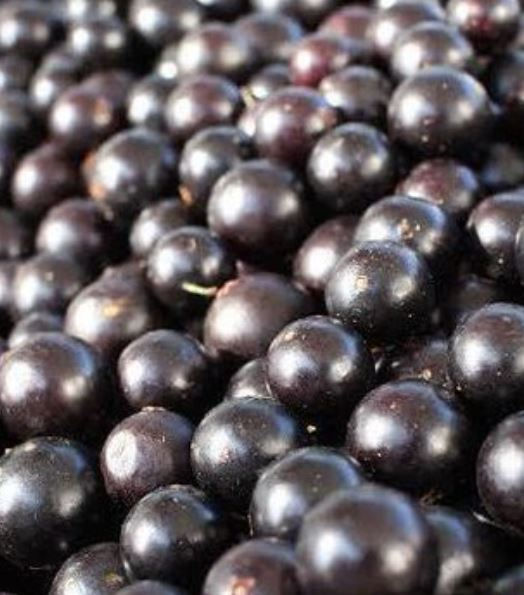Jabuticaba Fruit (2025 Guide): Benefits, Taste, Growing Conditions & Uses
- BeyondForest

- 2 days ago
- 5 min read
Updated: 10 hours ago
1.)About the Jabuticaba
2.)Jabuticaba Fruit
3.)Jabuticaba Fruit Benefits
6.)How Long Jabuticaba Takes to Fruit
7.)Jabuticaba Varieties
8.)Jabuticaba Tree Price
Jabuticaba (Plinia cauliflora) is one of the world’s most unusual and visually striking fruit trees, native to Brazil and highly prized across South America. What makes it unique is its cauliflorous nature—meaning the fruits grow directly on the trunk and main branches instead of the tips of the tree.
This creates a stunning appearance where the bark becomes completely covered in dark purple, grape-like fruits. Jabuticaba thrives in warm, humid climates and prefers deep, fertile, slightly acidic soils with constant moisture.

Image of Two potted Jabuticaba seedlings for sale at 700Ksh by Grace Gituku
The fruit itself has a thick, tannin-rich skin and a juicy white pulp with a sweet, grape-like flavor that’s perfect for fresh eating, juice, wine, jellies, and desserts. The tree is slow-growing but long-lived, capable of fruiting multiple times a year under ideal care. Rich in antioxidants, vitamin C, and polyphenols, Jabuticaba is celebrated not only for its taste but also for its powerful health benefits. It is increasingly gaining popularity in Kenya and East Africa for its exotic appeal and high nutritional value.
Want To Learn More About Loquats Click Here >>>
Jabuticaba Fruit
Jabuticaba fruit is a small, round, dark purple berry that grows directly on the trunk of the tree, giving it a unique and eye-catching appearance.

The fruit has a tough, antioxidant-rich skin and a juicy white or pinkish pulp inside. Its flavor is sweet, grape-like, and slightly tart, making it excellent for fresh eating, juices, wines, jams, and desserts. Jabuticaba is highly nutritious, packed with vitamin C, fiber, and polyphenols that support immunity, digestion, and overall health.
Want To Learn More About Dragon Fruit Farming Click Here >>>
Jabuticaba Fruit Benefits
Rich in Antioxidants: Packed with anthocyanins that help fight free radicals and slow aging.
Boosts Immunity: High vitamin C supports the body’s natural defense system.
Improves Digestion: Fiber in the pulp helps prevent constipation and supports gut health.
Anti-Inflammatory Properties: Reduces inflammation, helpful for arthritis and joint pain.
Supports Heart Health: Polyphenols may help reduce bad cholesterol and improve circulation.
Regulates Blood Sugar: Low glycemic index and plant compounds help stabilize glucose levels.
Great for Skin Health: Antioxidants protect skin cells, promoting a healthy, youthful glow.
Aids Weight Management: Low-calorie fruit that keeps you full due to high fiber content.
Improves Respiratory Health: Traditionally used to relieve sore throat, cough, and mucus buildup.
Promotes Detoxification: Helps cleanse the liver and eliminate toxins naturally.
Jabuticaba flowers are small, white, and feathery, forming directly on the trunk and main branches in dense clusters—a rare botanical feature known as cauliflory. Each flower has delicate, brush-like stamens that give it a fluffy appearance. These blossoms emerge repeatedly throughout the year, especially after heavy watering or rainfall. Their sweet fragrance attracts bees and other pollinators, ensuring excellent fruit set. Once pollinated, the flowers quickly transform into the signature dark-purple Jabuticaba fruits that cover the bark.
How to Grow Jabuticaba Tree
Image of Jabuticaba Seedlings
-Start by choosing a healthy seedling or grafted variety—grafted Jabuticaba fruits much faster.
With proper watering and feeding, Jabuticaba can flower and fruit multiple times a year, rewarding you with abundant clusters of its unique trunk-growing fruits.
-Plant it in deep, well-drained, slightly acidic soil (pH 5.5–6.5) enriched with compost or organic matter. Jabuticaba loves water, so maintain consistent moisture but avoid waterlogging. Mulch heavily around the base to keep the soil cool and moist.
-Place the tree in full sun to partial shade young plants prefer filtered sunlight, while mature trees enjoy direct sunlight.
-Apply organic fertilizers like compost tea, NPK 17-17-17, or slow-release fruiting fertilizers to boost growth. Prune lightly to maintain shape and airflow.
How Long Jabuticaba Takes to Fruit
Trees grown from seed can take 6–10 years before producing their first fruits, while grafted or hybrid varieties often fruit much faster, usually within 3–4 years.
Once established, Jabuticaba becomes a reliable bearer, producing multiple flushes of flowers and fruits throughout the year—especially when well-watered, mulched, and fed with organic fertilizer.
Jabuticaba Varieties
In tropical climates like Kenya, the Sabará and Red Hybrid varieties perform exceptionally well due to their fast flowering cycles and high fruit yield.
The Sabará Jabuticaba is the most popular and widely grown variety, known for its small, sweet fruits and ability to fruit multiple times a year.
Paulista Jabuticaba produces larger fruits with a thicker skin and grows into a bigger tree, making it ideal for spacious gardens.
The Red Hybrid Jabuticaba is one of the fastest fruiting types, often producing fruits in 2–3 years when well cared for.
The White Jabuticaba, a rare variety with greenish-white fruits and a milder flavor.
Jabuticaba seedlings are still rare in Kenya, which makes them more expensive than common fruit trees. On average, a healthy Jabuticaba seedling sells for 600–800 Ksh, depending on the variety, age, and nursery. Grafted or fast-fruiting hybrids can cost slightly more because they flower earlier and have stronger growth.
What is Jabuticaba fruit?
Jabuticaba is a unique Brazilian fruit that grows directly on the trunk of the tree. It has a thick purple skin and a sweet, grape-like white pulp with a rich, exotic flavor.
What does Jabuticaba taste like?
Jabuticaba tastes like a mix of grapes, lychee, and plum with a sweet, tangy finish. The pulp is juicy and refreshing, while the skin can be slightly astringent.
What are the benefits of Jabuticaba fruit?
Jabuticaba is rich in antioxidants, vitamin C, fiber, and anti-inflammatory properties. It supports immunity, digestion, skin health, and helps fight free radicals.
What is Jabuticaba called in English?
In English, Jabuticaba is commonly called the Brazilian Grape Tree or Tree Grape because the fruits resemble grapes and grow on the trunk.

How long does Jabuticaba take to fruit?
Seed-grown Jabuticaba takes 6–10 years to fruit, but grafted or hybrid varieties can fruit in 3–4 years with proper watering and fertilization.
Can Jabuticaba grow in Kenya or East Africa?
Yes. Jabuticaba grows well in warm, humid climates with rich, well-drained soil. It performs well in Kenya—especially in Nairobi, Kiambu, Murang’a, Nakuru, Embu, and coastal regions.
How big does the Jabuticaba tree grow?
A mature Jabuticaba tree grows 10–15 meters tall, though container-grown trees can stay smaller while still producing fruits.
How often does the Jabuticaba tree fruit?
Under ideal watering and feeding, Jabuticaba can fruit 2–5 times a year. Some varieties produce almost year-round.
Can Jabuticaba grow in pots?
Yes. Jabuticaba grows extremely well in large pots and still fruits heavily. Regular watering and organic fertilizer improve yields.
Yes. The fruit is commonly used to make Jabuticaba wine, juice, jam, jelly, and ice cream due to its rich, aromatic flavor.
Is Jabuticaba good for diabetics?
Jabuticaba has a low glycemic index and high polyphenol content, which may help regulate blood sugar. However, diabetics should consume it moderately.
Why does Jabuticaba grow on the trunk?
Jabuticaba exhibits cauliflory, meaning the flowers and fruits grow on the trunk to improve pollination and support heavy fruit loads.
Fresh Jabuticaba fruits last 3–4 days under room temperature and up to 7–10 days when refrigerated due to their delicate skin.
Yes, but it requires constant moisture, organic mulch, and acidic to neutral soil. Once established, it is hardy and fruits generously.















Comments